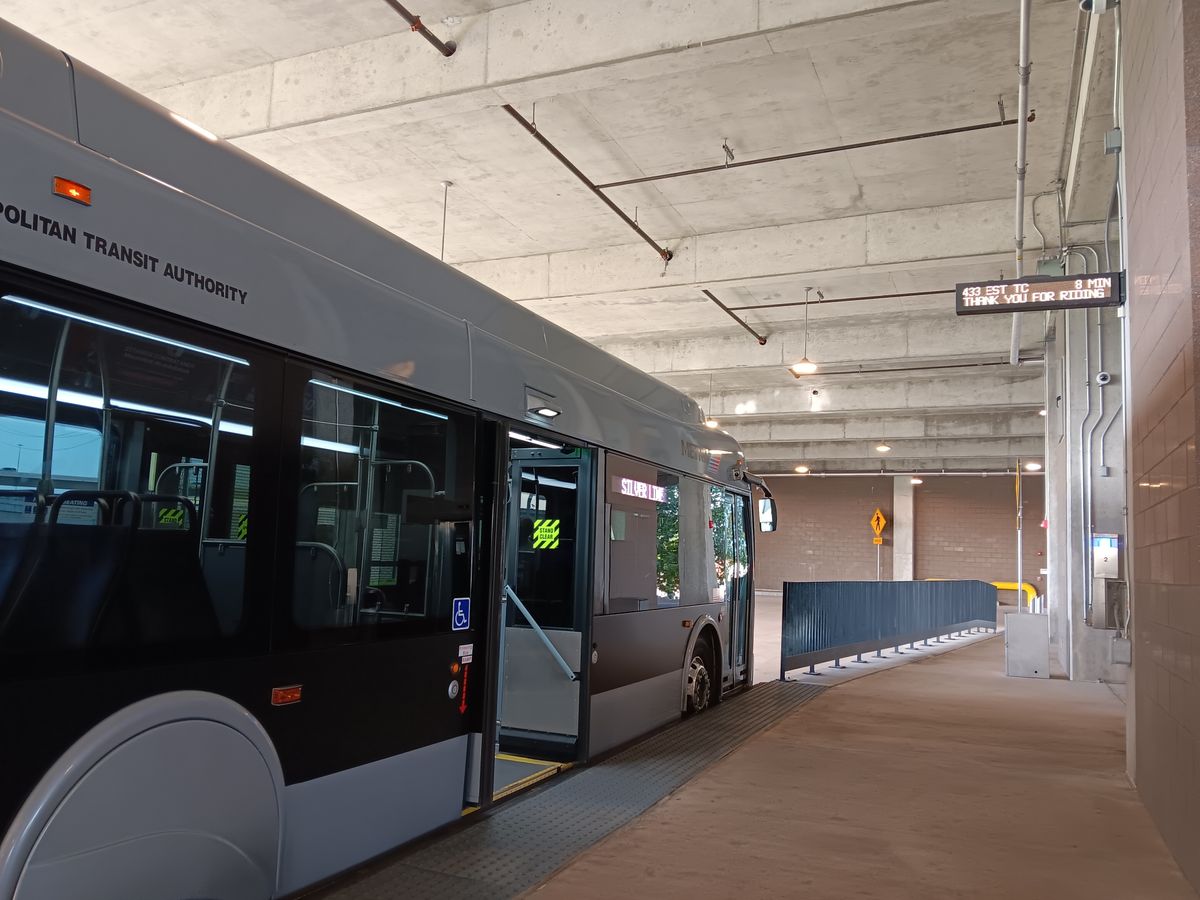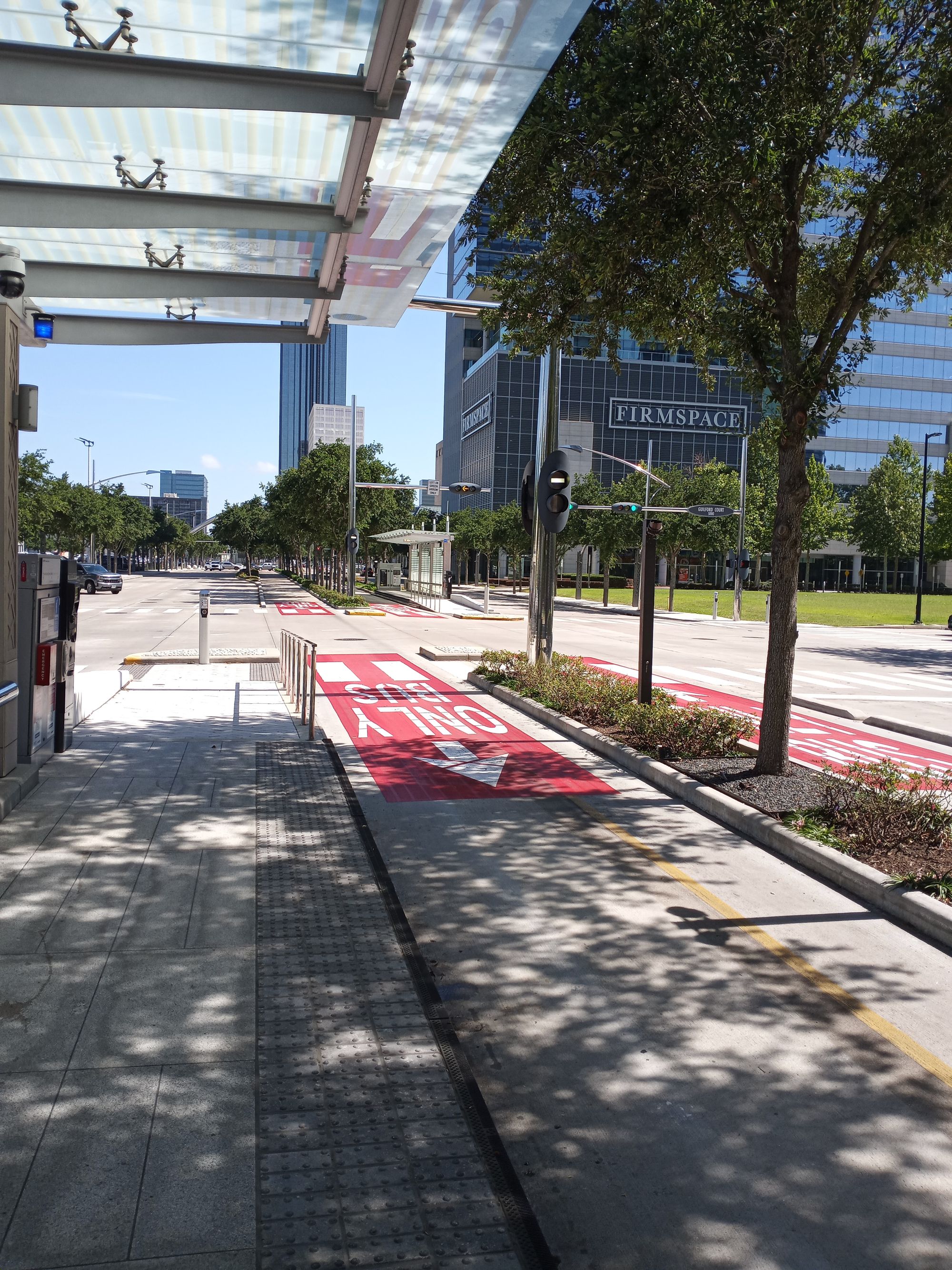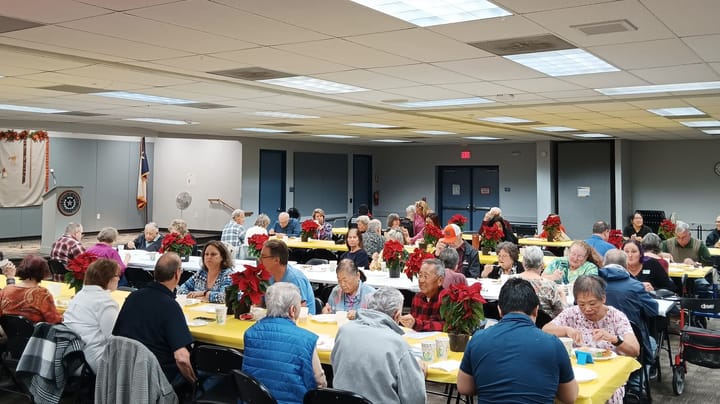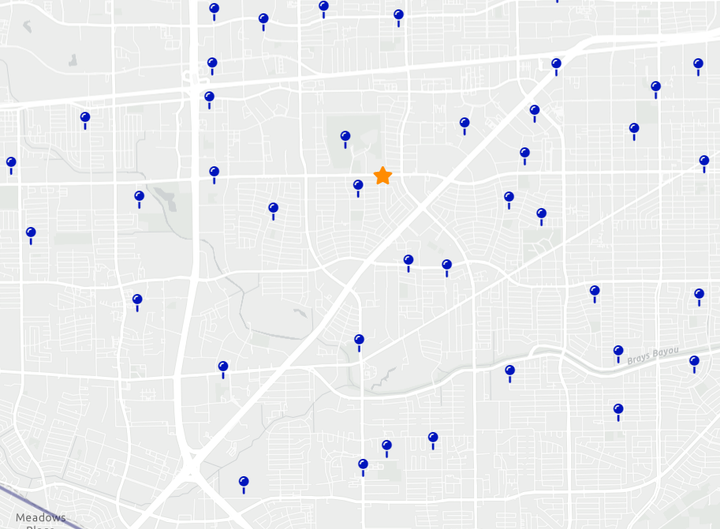An Underwhelming Trip on METRO’s Low-Rider Silver Line

Empty blue seats stared back at me as I sat for eleven minutes on a silver bus at the Westpark/Lower Uptown Transit Center (TC), joined only by a woman in a blue-green shirt, a man with a black suitcase, and a quarter-full Starbucks iced coffee (or tea?) abandoned on the seat across from me.
You may have seen the new silver buses driving through the Galleria in their own dedicated lanes. That route—the Silver Line—is currently the only example of a METRORapid bus line in Houston, but METRO wants to build more of them.
METRO is working toward three more METRORapid routes: the University Corridor project, the Inner Katy Corridor project, and the Gulfton Corridor project.
That last one is a planned extension of the current Silver Line. Right now, the line runs from the Northwest TC near Memorial Park to the Westpark/Lower Uptown TC on the northeast side of Gulfton. But METRO wants to extend it southwest, all the way to Hillcroft and Bissonnet.
The pros of the Silver Line, as advertised on METRO’s website, include its “dedicated, transit-only lane to move through traffic” and its ability to “zip through intersections while others wait for the traffic light” (i.e. it has signal priority).
The cons are obvious: if it has signal priority, it will naturally slow other traffic; and if it has its own dedicated lanes, it may take away regular traffic lanes in some areas. The construction will also involve narrowing median strips and removing trees.
Are the benefits worth the costs? With all the fanfare, one would expect the Silver Line to be popular with METRO riders. But its ridership stats are some of the lowest in all METRO.
METRO has only released stats for the first five months of this year. So far, May has the best stats for the Silver Line: 7.98 boardings per revenue hour and 0.96 boardings per revenue mile on weekdays. But in the same month, most METRO lines had at least 12.0 boardings per revenue hour and 1.0 boardings per revenue mile. The #2 Bellaire line had 31.71 boardings per hour and 2.82 per mile; #4 Beechnut had 21.49 per hour and 1.68 per mile.
If the Silver Line is so much better than normal bus lines, shouldn’t it get more riders, not fewer? Why are so few people riding it?
I decided to ride the Silver Line to find out.
On my first trip on June 13, I was surprised by how few people I saw—but maybe it was a fluke, I thought.
I didn’t get the chance to return till July 18.
I jogged down the stairs of the Westwood/Lower Uptown TC at 5:36 PM, just as a Silver Line bus pulled up to the station. I swiped my Q card at the mini kiosk at the station (don't make my earlier mistake of boarding first), then boarded along with the woman in green-blue. I attempted to interview her, but my Spanish skills were not up to the task (I really need to get DuoLingo).
Apparently, the driver was on break, because we sat there for eleven minutes. (I’ve learned that that an end-of-route break is normal for METRO lines.) A man tugging a black suitcase joined us in the passenger section, and then the driver pulled away from the station at 5:47 PM.
Before we could pull out of the TC driveway and turn onto Westpark Drive, the driver had to get out and talk to the driver of the black car ahead of us, which was waiting an awfully long time to turn left.
A honk finally sent the car scurrying, and we turned east onto Westpark Dr at 5:51 PM, then north onto Post Oak.
At 5:53 PM, we hit our first stop on Richmond. Lights flashed ahead. A METRO police car was parked in our bus-only lane, right at the edge of the intersection. Another METRO police car was doing the same thing in the southbound bus-only lane on the other side of the intersection.
Was our driver being pulled over? Nope. Next to the other traffic lights, a white bus signal flicked on. It was our turn to drive through. The police car pulled out of our lane and to the right, essentially telling the other cars to stay where they were. Once we passed through the intersection, the police car backed into the bus-only lane again.
Apparently, people haven’t been respecting the Silver Line’s signal priority.
At 5:55 PM, we stopped at the West Alabama station. There were no more police cars, and nobody boarded our bus, but there were three people waiting at the southbound station on the other side of the miniature “bus street.”
6:00 PM: we hit the Westheimer station. The man with the suitcase gets off, and two young men in black hop on. There is now a stupendous total of four passengers on the bus, including me.
6:02 PM: we stop at Guilford. Nobody gets on. Across the street, a man in a bright blue shirt squats on the tiny concrete lip that juts out at the base of the southbound bus shelter wall. Silver Line bus stops don’t have seats, so this man decided to make one.

6:05 PM: we stop at San Felipe. Nobody gets on. One woman in a pink sweatshirt waits at the other platform.
6:07 PM: the woman in blue-green gets up and grips one of the handles hanging from the ceiling. She gets off at Four Oaks. Nobody gets on. There is now a whopping total of three passengers on the bus.
6:08 PM: Uptown Park. One woman gets on; one man gets off. Still three passengers.
Post Oak curves east, and then the bus turns left underneath the 610 freeway, onto a special ramp that turns into a two-way “bus road” elevated above the freeway. The cars below look small.
The driver accelerates to what feels like sixty. We’re almost to the Northwest TC.
6:10 PM: I’ve been on the bus for thirty-four minutes, including the driver’s break time. I check my phone: Google Maps says that to get from the Westpark/Lower Uptown TC to the Northwest TC would take twenty-two minutes by car right now (due to an accident adding five minutes to the trip).
6:12 PM: The elevated lane descends. We stop at a light, then turn right into another set of double bus-only lanes in the middle of Old Katy Rd.
6:14 PM: After another right, we pull up to the Northwest TC and get off.
The whole trip took thirty-eight minutes (only twenty-seven if I don’t count the driver’s eleven-minute break). I had traveled approximately five miles.
Not bad, but not particularly impressive, either. I’ve rode nine miles on #4 Beechnut (a regular METRO line) in thirty minutes before.
What surprised me more was how few passengers there were. The bus had about thirty blue seats (and let’s not forget the hanging gray straps for standing passengers). Yet there were never more than four of us on the bus at a time.
Perhaps other METRO riders aren’t very impressed by the speed either?
But maybe there would be more of us on the return, I thought.
The bus zoomed through a turnaround loop and pulled back up to the other side of the station. I re-boarded at 6:16 PM. The driver trudged off the bus and sat on a metal-grille bench, looking at his phone.
This time, the break only lasted eight minutes. He walked back onto the bus, pulled out of the station at 6:24 PM, and retraced his previous drive.
I’ll spare you the stop-by-stop play this time, but I saw a woman sitting on the low—as in about one foot high—concrete wall next to the ramp at the San Felipe station. Again, she had decided to make her own seat since the station didn’t have one.
During the whole return trip, I saw three people board my bus. I decided to talk to a man with a green plaid shirt, a black moustache, and a blue duffel bag, who turned out to be a regular Silver Line commuter named Leo Simon. You can read his thoughts on the Silver Line here, but the brief version is that he was excited about the prospect of extending it southwest.
At 6:50 PM, we pulled into the Westpark/Lower Uptown TC. I said farewell to Simon, the driver walked out, and a display overhead said that the bus would leave again in ten minutes.
Not including the driver’s break, the return trip had taken twenty-six minutes. The whole round trip, including waits, had taken an hour and fourteen minutes.
I waited for the driver to return, then asked, “Is the bus always this empty?”
The man, whose shirt read “J. Sarrazola,” replied, “Sometimes it’s a little more busy…it was a low day today.”
But this was about the same as my first trip. And again, METRO’s stats confirm that this bus line just isn’t as popular as others.
I asked METRO’s press office to explain the low ridership. Monica Russo emailed this response: “The METRORapid Silver Line debuted during the COVID-19 pandemic when transit agencies worldwide saw sharp declines in ridership. Projected ridership was based on pre-pandemic work patterns, which are still changing and vary depending on job type.”
Fair, but not super convincing anymore. COVID seems to be everyone’s excuse for everything, and it’s getting old. Most Houstonians I know stopped wearing masks well over a year ago.
The bottom line is that Silver Line ridership didn’t meet METRO’s expectations. Could the Gulfton Corridor project be an attempt to save the line by connecting it to the high-density population center of Gulfton? In theory, it seems like a smart way to boost ridership.
So I decided to head to Burnett-Bayland park, one of the proposed stops for the Silver Line extension, to find out what people in Gulfton thought of the project.
Along the way, I learned what METRO's press office meant when they told me that Gulfton residents “face many physical barriers in getting around their neighborhood, as well as getting to destinations outside of it.”
You can read about my little jaunt on the 309 bus line next week, but the main takeaway is that even if the Silver Line is not as amazing as METRO makes it out to be, it would almost certainly be faster and more convenient than most of the public transportation currently available in Gulfton.
Still, the METRO press office would not give me a ridership estimate for the Gulfton Corridor extension. They seem to be taking a long-term view: “While measuring the benefits of METRORapid expansion may take decades, we know that as our community grows, so will traffic.”
Hopefully, though, the next METRORapid lines are a little less underwhelming.



Comments ()